Washington D.C. – According to a new Consumer Federation of America analysis of 1,163 of this year’s new vehicles, fuel efficiency continues to increase for 2015 on a model by model basis. However, individual car company fleets, are backsliding on their overall fuel economy performance.
From 2014 to 2015, the percent of vehicles with an Environmental Protection Agency (EPA) fuel economy rating of at least 23 miles per gallon (mpg) ticked up from 50.5 percent to 52 percent, and the percent of vehicles with fuel economy at or below 16 mpg, the so-called gasguzzlers, declined from 8.5 percent to 6.1 percent.
On the other hand, the 2015 improvement disguises significant variation in the fuel economy progress made by individual car companies. While some automakers have made important progress in increasing the number of models that comply with the year’s Corporate Average Fuel Economy (CAFE) standard, for example, Volvo (29 percent vs. 0 percent in 2014), Honda (57 percent vs. 51 percent in 2014) and Mercedes (15 percent vs. 12 percent in 2014), a number of companies slid backwards. Those registering the biggest declines in fuel efficiency were Kia (18 percent in 2015 vs. 40 percent compliance in 2014), Subaru (43 percent vs. 52 percent in 2014) and GM (19 percent vs. 27 percent in 2014). “In 2015, seven auto companies met or exceeded their 2014 performance,” said Jack Gillis, author of The Car Book and automotive expert for CFA. “There is no doubt that since the announcement of higher CAFE standards, many car companies have improved their selection of vehicles with greater fuel efficiency, proving that 54.5 mpg by 2025 is achievable. The fact that the number of cars getting over 23 mpg has risen by almost 40 percent in the last ten years is strong evidence that reaching the goal of 54.5 mpg by 2025 is indeed attainable,” added Mr. Gillis.
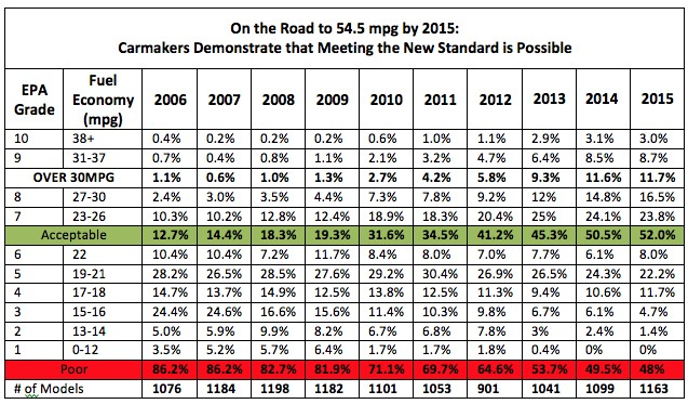
In looking at the 2015 models, one of the biggest jumps was in the 27-30 mpg category, which improved from 14.8 percent to 16.5 percent in 2015. While traditionally, the most significant efficiency gains are found in smaller vehicles, this year the Ford F-150, which had a 2014 fuel economy range of 13-19 mpg, jumped to a range of 17-22 mpg in 2015. By switching to a lighter aluminum body, the majority of the newly designed F-150 trims are CAFE compliant for 2015. And, one F-150 trim line, in particular, is compliant until 2021.
The following chart compares the percentage of each company’s models that are CAFE compliant in 2014 and 2015. Seven companies matched or improved the percentage of models complying with CAFE over 2014; eleven companies backslid.
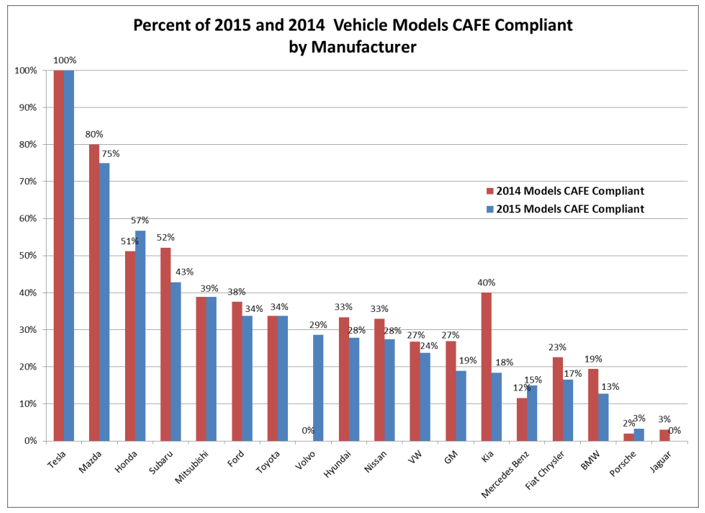
One of the reasons that 2015 saw a slowdown in CAFE compliance for many car companies is that while the CAFE standards increase each year, manufacturers can only significantly improve the fuel economy of their “all-new” models. In comparing the CAFE compliance of “all-new” models in 2014 with 2015, there were fewer CAFE compliant vehicles in the “all-new” 2015 models. Another reason for fewer compliant vehicles was an increase in the number of newly introduced SUVs and light trucks, which were not designed to meet the standard. Individual vehicles failing to meet the standard can occur because CAFE is a corporate average—it’s the manufacturer’s overall fleet that has to meet the goal. Therefore, non-compliant SUVs and light trucks can be balanced out by other vehicles that exceed their CAFE requirement.
As the table below shows, 44 percent of the all-new 2015 vehicles were light trucks and SUVs, compared to 34 percent in 2014.
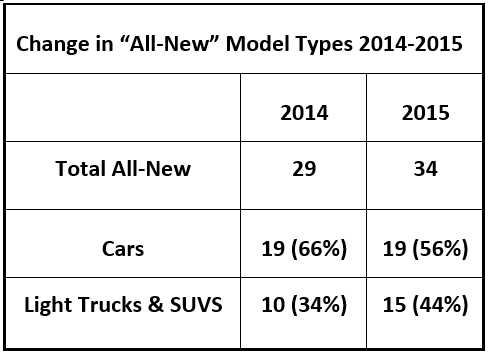
The percentage of cars that were CAFE compliant in 2015 decreased slightly from 2014 (58 percent to 42 percent), but the percentage of CAFE compliant light trucks and SUVs declined significantly (from 80 percent to 40 percent). With the exception of the Ford F-150, most of the SUVs and pickups were not CAFE compliant, dropping the percentage of “all-new” vehicles that were CAFE compliant from 66 percent to 41 percent. See table below.
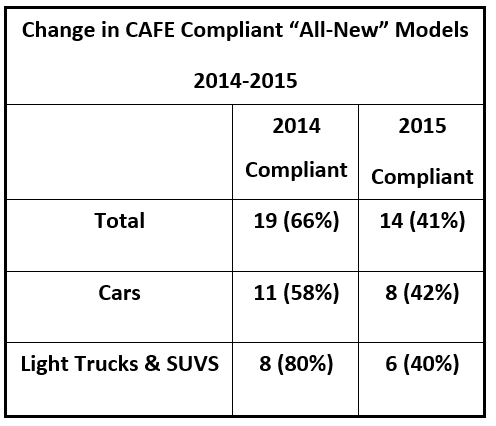
Finally, in reviewing the “all-new” models, we determined how many years into the future each model would continue to comply with their CAFE requirement, which increases every year. Vehicles that meet the requirement for a number of years help the manufacturer continue to comply with the standards, which is good news for drivers.
“Consumers realize immediate savings at the pump with a CAFE compliant vehicle,” said Mark Cooper, Director of Research, CFA. “Those purchasing these efficient models can rest assured they will receive a return on their investment for years to come.”
The following charts show the CAFE compliance of the 2015 vehicles (first chart) and 2014 vehicles. Examining the “all-new” vehicles that each manufacturer puts out provides some context for why they have dropped in CAFE compliance. For example, Kia’s “all-new” vehicles consisted of a luxury car (K900) and SUV (Sedona), neither of which is CAFE compliant.
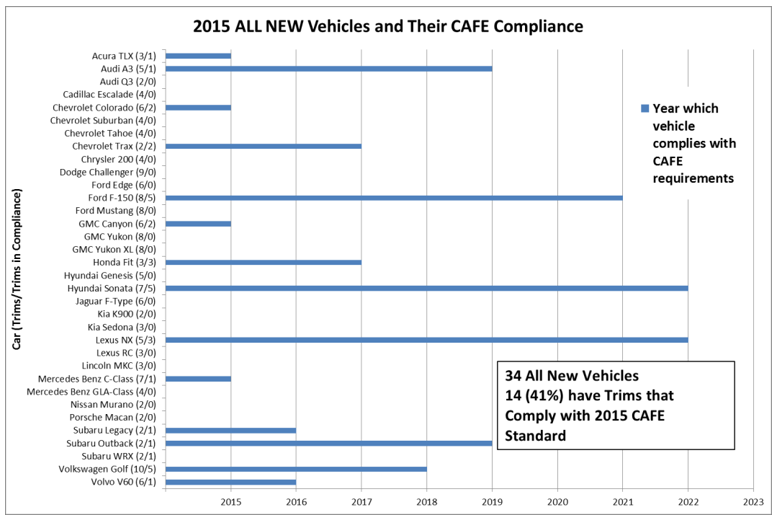
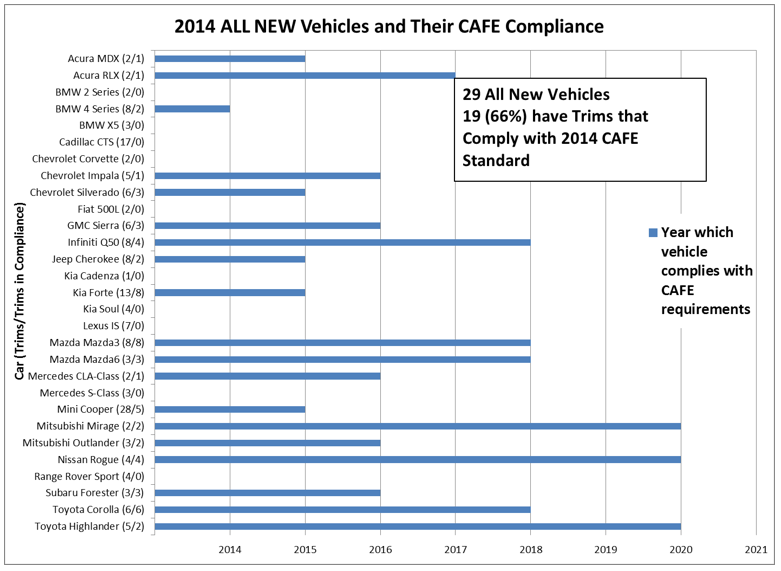
“While there was backsliding by some of the manufacturers, a number of others are demonstrating that 54.5 mpg by 2025 is, indeed, achievable. The 54.5 mpg fuel economy standards represent a historic consensus that brought together automakers, labor unions, consumer organizations and environmental groups to benefit our national and economic security, the environment and consumers through reduced fuel consumption and more vehicle choices,” said Gillis.
CFA is an association of more than 250 nonprofit consumer groups that was founded in 1968 to advance the consumer interest through research, advocacy and education.

